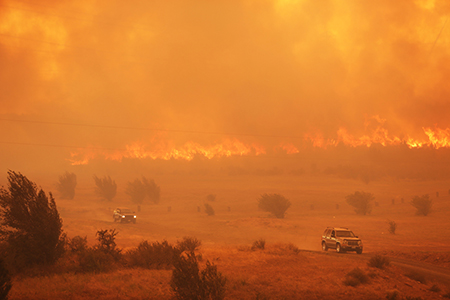
We have to learn to live with fire while reducing the risk to what we value most, according to professor Mike Flannigan.
As another wildfire season is well underway in Alberta, it's important to know what fire researchers are doing to help predict and prepare for future fires.
Wildfires need three things to live: an ignition source; fuels to burn; and fire-conducive weather. Once started, wildfires can spread rapidly, especially during extreme fire weather conditions -hot, dry and windy.Researchers anticipate that wildfire activity will increase in some parts of Canada due to climate change. Such climate-driven changes in future wildfire regimes could lead to increased burning due to a positive feedback loop: more fires mean more greenhouse gas emissions, and this could lead to more warming and thus more fires, and the cycle continues.
"More extremes are likely in the future," said professor Mike Flannigan, a wildland fire expert in the Faculty of Agricultural, Life & Environmental Sciences. "It doesn't take much change in climate to cause a fire."
While we can never eliminate the risk of loss from wildfire, there are projects underway that aim to help monitor and predict wildfires, thereby giving communities more time to prepare and evacuate.
"The most effective time to catch and stop unwanted fire is right after it starts," said Flannigan.
New satellite underway
One exciting advancement in wildfire monitoring is the use of remotely sensed data from satellites. WildFireSat is a wildfire monitoring satellite in development by the Canadian Space Agency. The satellite will monitor the radiated power from wildfires to learn their characteristics and provide near real-time information to support wildland fire management and research, improved smoke and air quality forecasting; and emission measurements that are part of international requirements for carbon reporting. WildFireSat plans to monitor the entire country daily and deliver its data within 30 minutes.
AI predicts extreme weather events
Researchers at the University of Alberta, alongside colleagues from the Canadian Forest Service and the University of Waterloo, are also hard at work applying machine learning and artificial intelligence (AI) applications to help understand and predict wildfires.Flannigan and the team are developing several machine learning projects to aid with the challenges future fire activity may bring. For example, Flannigan's lab most recently used self-organizing maps (a type of neural network) to predict extreme fire weather in Alberta using atmospheric pressure gradients. Work is ongoing to develop an automated fire weather prediction system that will aid in operational firefighting planning.
Changing our approach
In the past, wildfires have often been seen as something negative on the landscape. However, there is a growing recognition among researchers of the need to balance the negative aspects of fire with the ecological benefits."While there is no single factor that has created the current wildfire environment, there is also no single solution that will solve the problem," said Flannigan. "While improved fire science and having resources ready to battle fires in and around communities are essential, wildfires that burn in regions with fewer values will need to be left to burn."
"The reality is, we cannot afford to fight fires in the wildlands at the cost of not having resources available to respond to fires that become imminent threats to societal values."
The challenge, according to Flannigan, is identifying the threat of each fire and deciding where to put resources - decisions that are full of uncertainty.
"We have to learn to live with fire," said Flannigan. "We must also work to reduce the risk to what we value most and accept the trade-offs this requires.
Wildfire facts
Average annual number of wildfires in Canada: 8,000Average annual number of hectares burned: 2.5 million (roughly the size of Nova Scotia)
Average annual Canadian wildlife management costs in millions of dollars: 800
Percentage of fires caused by human activity: 60 (lightning is the other major cause)